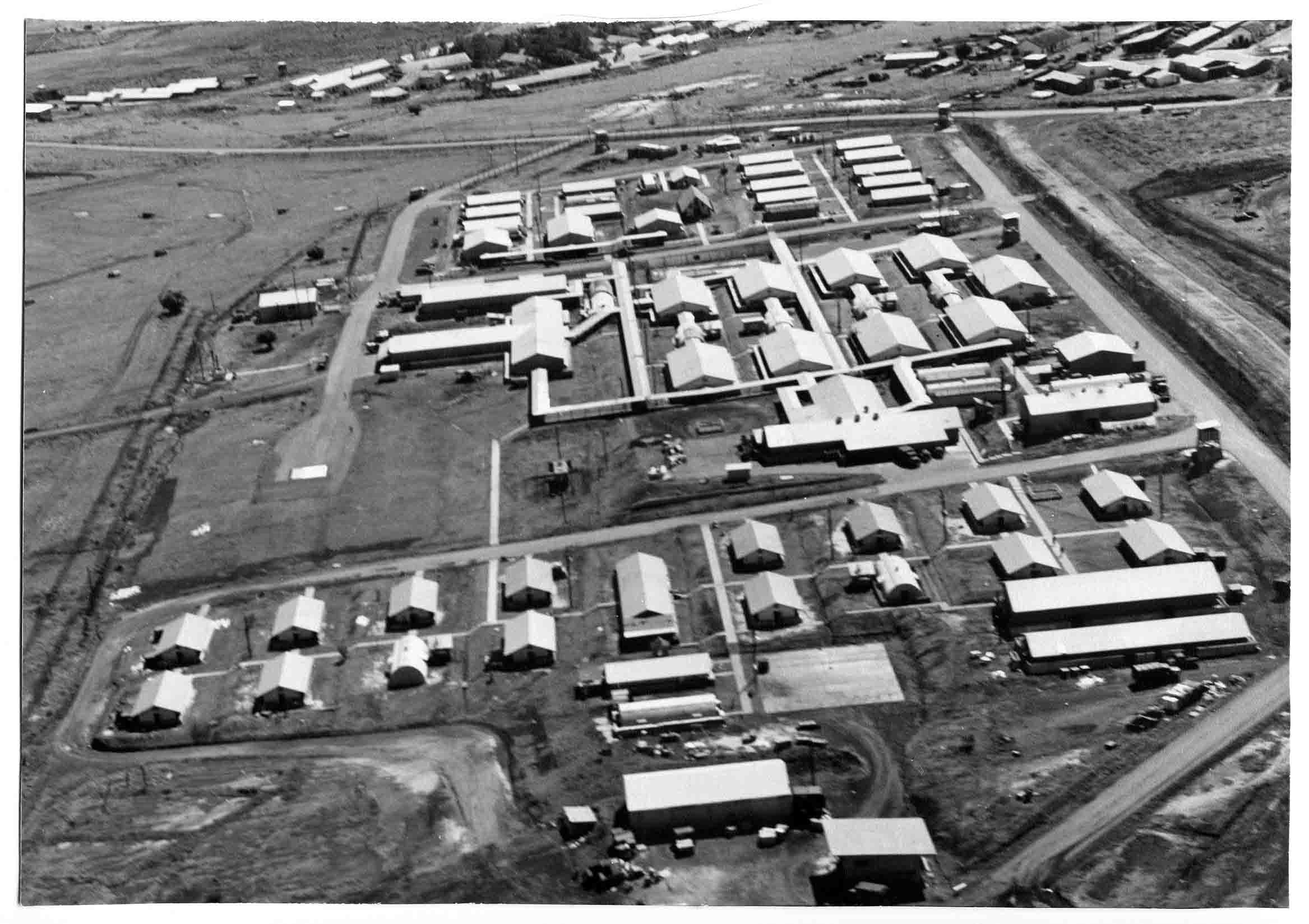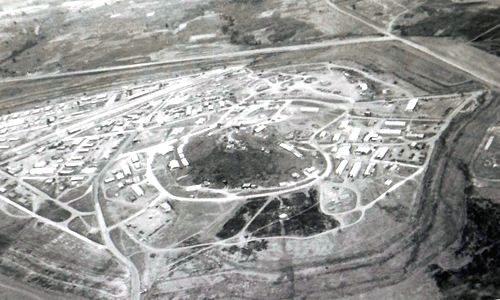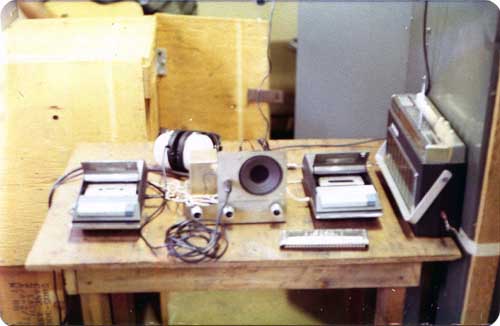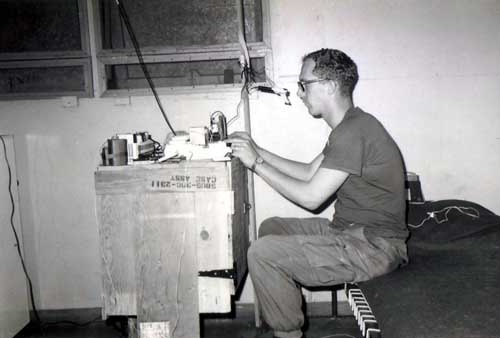
I arrived in Vietnam in March of 1971. It took several days of processing and travel in-country from Bien Hoa Airbase, my point of entry, thru Long Bien thru Nha Trang to Pleiku where I spent the next 11 months assigned to the 146th Signal Company. Our radio shop and living quarters were on a relatively small 26 acre compound, historically a fully functional, 400 bed, 71st Evacuation Hospital (right). It was just a small part of the huge military complex surrounding the city of Pleiku. Pleiku itself is located in the middle the mountainous northern region of South Vietnam called the Central Highlands, also known as IICorps Tactical Zone during the war.
It takes a while to adjust to life in a war zone, the culture shock and the general routine of things. But as you acclimate to new environments, at some point, you seek out your own preferred activities to pass the time. We had access to a pool, courtesy of the downsizing 71st Evac Hospital, which also surrendered some quite adequate living quarters in, fortunately unneeded, hospital wards. The war was starting to wind down and facilities, equipment and even troop strength was gradually becoming surplus. That fact ultimately contributed to my tour being shortened to eleven months, down from the 12 specified in my original orders.
Occasional road trips to shuttle equipment to field sites or upper echelon maintenance depots added some diversity and distraction to the daily routine. If you were a photographer, there was a photo lab at the air base next door where you could develop and print your own film. The majority of my black and white pictures shown on this site were developed at that lab. I don't remember if color processing was available. I didn't have the skills for color processing and always sent my color film to the professional processors. After dark, our options were even more limited. In late afternoon, the gate was closed and we were confined to our 1/2 sq. mile compound with it’s concertina wire perimeter until morning. Movies and the rare travelling band were sometimes available but I don't remember them fondly. The Air Force had some pretty good bands at their EM club, but the few bands we hosted were pretty bad. All the good stuff must have been down south in Saigon. I'll leave it there.
Surprisingly we had local English language TV (evenings only) as well as AM and FM AFRTS (Armed Forces Radio and Television Service) stations. The TV was nice, but with just one channel and a short broadcast day was far short of the multiple channels available back in the world, much less the 100's of 24/7 channels expected by today's short attention span viewers. One small benefit: we never had problems keeping track of the remote control. Both the AM and FM stations had reasonable programming but the audio fidelity was awful. I don't recall the specific problem but I think some, if not most, of the programming originated 300 miles way down south in Saigon [renamed Ho Chi Minh City by the ultimate victors] and the broadcast relay stations degraded the fidelity of the music. It was tolerable, but who ya gonna call?
It was inevitable that I would eventually feel compelled to experiment with some form of radio communications to occupy my spare time. Back in the world, I had built my first crystal radio at age 10. It wasn't one of those with a 1N34 germanium diode either. It had a galena crystal and a springy "cat whisker" needle that one would carefully probe about to find a hot spot for a good detection. Cutting edge technology. The whole concept of wireless communications fascinated me. I was fascinated with receiver theory, but my attention sooned turned to the far side - the transmitter. Radios are so common in everything today that we rarely give it a thought. It's too cliche to say we 'take it for granted' since most everything is taken for granted - long lasting car tires, off the shelf (or online) shopping, sewer systems - we can all name a million things that we rarely think about, until we don't have them. It's easy for even me to take the omnipresence of two-way radios for granted, but not often. I am still amazed at how two black boxes can interact thousands (Should I say billions?) of miles away without any wires (No million-mile long wires? Well duh!)
Jumping ahead, a few years later, I built a toy AM transmitter from another kit and had come full circle in the transmit-receive cycle. It wasn't long before I was building more sophisticated radio receivers. Eventually I learned the Morse code, earned my WN5QBA Novice license in 1966, purchased some serious radio equipment and began working the world. Within nine months I had my General Amateur Radio License and in 1968, my 2nd Class Commercial Radio Telephone FCC license.
So after nearly a year of boot camp, AIT ((Advanced Individual Training for 31L2T Radio Relay Carrier Technician MOS (Military Occupational Specialty) classification)), I ended up in Pleiku where I had no, zilch, HAM radio privileges. Briefly, I tried working 6-Meter FM with an army radio using an imaginary KH6 call, but I never got a reply to my CQs, or ever heard anyone for that matter. That wasn't going to work.
Since the war was winding down (for us GIs at least) a lot of equipment was being turned in to our shop from field sites reducing their inventory as they shut down. That provided a marvelous opportunity for me to scavenge an excess intercom for conversion to what would become the Peanut Whistle of the Central Highlands, so named after the HAM (amateur radio) nickname for a low power transmitter. That intercom was the perfect foundation for my bootleg pirate FM broadcast transmitter. The 3-tube chassis with a basic power supply conveniently provided most of what I needed. One tube was the rectifier of the mostly intact power supply and the other two were available for the transmitter circuitry. Ordering parts through the government supply channels was slow and tedious. Re-purposing the intercom chassis solved a lot of problems but we were a service shop, but there was no Radio Shack within driving distance. Cannibalization was the name of the game.

I needed a design and I already had it in my head. I built many one-transistor transmitters for AM, FM, TV (novelty TV jammers for neighborhood TVs), and HAM bands based on a simple schematic long committed to memory from the 1964 edition of an Allied Radio “Understanding Transistors” booklet. All I had to do was adapt the transistor circuit to one of the extra intercom tubes. The third tube was only needed to keep the filament string of the other two under management.

Dustoff Huey landing at the hospital helipad. (center)
The Air Force's 'Radar Hill' antenna towers in the background. (left of center)
Based mostly on previous experience I was able to create a suitable variable tank circuit that would resonate over the whole of the FM band. Since I worked on FM radios back home, I just kind of knew how big the air-wound coil would have to be. It was not long before I had a working one tube oscillator producing enough power to light up a small incandescent bulb with pure RF energy. I ran the calculations for a 95 MHz 1/4 wave antenna and mounted an Army ground plane antenna outside, tuned to match, on a short pole to avoid drawing too much attention. After measuring the plate voltage and loaded and un-loaded plate current, I ran the numbers and estimated an output power of about 7 Watts. That power and antenna was perfect to easily cover the 26 acre compound and my target audience. I had no interest in reaching out further. My main concern was that the Air Force compound was literally next door and had a communications center on top of Radar Hill probably a third of a mile away by line of sight. I had no idea how clean my transmitter signal was and figured it wouldn't take long for them to DF me if I interfered with any of their systems. Thankfully, no one ever came around with their RF sniffers. Nevertheless, I had one reception report from Artillery Hill which was a couple of miles away.
 Artillery Hill (left)
Artillery Hill (left)
The main FM modulator was as simple as it was superb. The heart of it was a simple reversed biased diode lightly capacitively coupled to the tank capacitor, which was used as a varactor diode. It was driven directly with external audio sources so virtually no distortion was introduced by my circuitry. Other than coupling capacitors and variable resistors, there was simply nothing to degrade the audio quality. That is the basis for my sincere claim to the best hi-fi transmitter in the region. The quality was limited only by the quality of the source. The cassette recorders sounded quite good themselves, but when we connected SP5 Gray's reel-to-reel, I venture to say at that point, the hi-fi quality was more dependent on the consumer’s receiver quality. As an added advantage, since my transmitter was designed for FM broadcast radios I could use the wideband modulation suitable for the consumer FM radios. Now there were other pirate radio stations in Vietnam, but to my knowledge they all used military radios which had the limited bandwidth of voice communication radios and so not only was the fidelity limited, but the narrow band modulation was not compatible with consumer radios. You pretty much had to have a military receiver to get proper reception of a military transmitter. On the plus side of military radios, their signals were stable, and had higher power. My transmitter was quite crude and would drift. The only means of setting the frequency was to tune it for best reception on my radio monitor sitting by its side. Had it not been for analog radios with AFC, it would probably have been somewhat tricky for the audience to keep it in tune.

What I'll loosely call my "mixer" consisted of inputs for two portable cassette players and a microphone each with its own fader control to create those professional transitions from song to song or the ever annoying DJ talking over the music. When using the reel-to-reel, I simply mixed the stereo and fed both inputs. (My greatest disappointment for my pirate station was that broadcasting in stereo was simply impossible with my resources. That was probably just as well because it would have been a much more complex signal and possibly a more serious risk to interfering with authorized military communications.) The microphone was from one of the cassettes and a scavenged audio amp circuit board from a cheap pocket transistor radio provided the gain to feed the modulator. I left the intercom speaker in place and used it to cue up songs on one cassette while playing the other. The adjacent table radio provided an acceptable measure of frequency and modulation control.
To add a dubious measure of anonymity to the station, we all used nicknames based on the Funny Face drinks. (Pictures illustrated elsewhere on this site.) Funny Face drinks were basically a different brand of the original Kool-Aid. We occasionally received care packages from charitable support organizations for which we were very grateful. Among the toiletries and snacks were packs of assorted Funny Face flavor packets. Now to back up a bit, there were two common pastimes for us GIs: some chose heroin and some chose alcohol. I chose alcohol, bourbon and vodka to be more specific. For mixers we usually had cokes, kept cool in our personal mini-fridges. That worked great for the most part, but we did run out once in a while. Not to be defeated, I experimented and to my delight, I discovered that vodka mixed very well with the Choo-Choo-Cherry flavor of the Funny Face lineup. My persistent use of that combination earned me the nickname of the Choo-Choo-Cherry-Kid which I covertly used as my on air code name. The other guest DJs followed suit by selecting other flavors for their monikers, though I doubt if they also used their flavor of choice as a mixer.
 Stan Nelson (left)
Stan Nelson (left)
The music we played was the typical rock of the time but there was a smattering of country and 50’s. We played to please and would take requests and/or play any tape brought to us. When we had a pool party, I could hook up a long playing tape on the reel-to-reel so everyone could synchronize their radios to a common station. The hours of operation were usually in the evening, but not always regular. Anyone who wanted a turn was welcome to DJ with his personal playlist. By chance,one of the volunteer operators, Stan Nelson, was actually employed as a DJ back in the world. His professional experience added a touch of class to the broadcast as well as provided some helpful tips raising the competency level of the rest of us.
In January of 1972, I transferred back to the world with orders shortening my tour to eleven months. I had asked for a 6 month extension which was rejected. So when the time came, I shut down the station and brought it home in my baggage. After packing that homebrew transmitter around with me for many years, I finally tossed it out. It's probably not a bad thing that I did. It was not very attractive and was unlikely to end up at the Smithsonian, but I do regret disposing of it now.
Had it not been for SP5 Gray recording a couple of hours’ worth of the Peanut Whistle of the Central Highlands, live, my memories would have continued to fade. Thankfully, though unknown to me at the time, SP5 Gray made those recordings and brought them back when he returned. We had not been in contact since our overlapping tours and by chance he found me on the internet. It was not long before he converted the tape to digital format. Even today, I find the recording's quality to be quite good, considering it he recorded from his portable radio to tape during the original broadcasts and then converted the nearly four decades old tape to a digital format. To this day, I am still amazed that those broadcasts were captured. I cannot express my gratitude enough that SP5 Gray saved that very personal bit of history.
Fortunately, we were never tracked down and shut down by the MPs or other radio police. We operated when we pleased, as we pleased. We had no anti-war ranting as was heard on some more infamous pirate stations, just good music with good attitude. I'll never know, but I hope the listening audience enjoyed listening to the Peanut Whistle of the Central Highlands 95 FM on the dial as much as we enjoyed providing the best hi-fi music in the region. Thanks to all that contributed to its success. A small thing perhaps, but so far from home in a hostile environment, even little things were treasured.
SP5 Schmidt
a.k.a the Choo-Choo-Cherry-Kid, Pleiku 1971-1972



